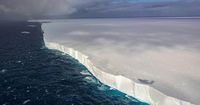For nearly four decades, the colossal iceberg A23a has been an unmissable, drifting landmark in the Southern Ocean—an icy behemoth that once dwarfed most cities and inspired awe among scientists and sailors alike. Now, this king of the seas is in its final days, with experts predicting its complete disappearance within weeks, marking the end of an extraordinary chapter in the history of Antarctic ice.
According to the British Antarctic Survey (BAS), A23a's story began in 1986, when it broke away from the Filchner-Ronne Ice Shelf in Antarctica. Unlike most icebergs, which quickly melt or drift away, A23a had a unique fate. After calving, it ran aground on the seabed of the Weddell Sea, where it remained stuck for over 30 years—a stationary giant, weathering the relentless polar elements.
"Most icebergs don't make it that far," said Andrew Meijers, an oceanographer with the BAS, as reported by blue News. "A23a was really big and therefore lasted longer and got further." Its sheer size was indeed remarkable. Just a few months ago, satellite imagery from the EU's Copernicus Earth observation program showed A23a was roughly the size of Mallorca, weighing in at nearly a trillion tons. For perspective, that's about the same mass as ten thousand fully-loaded aircraft carriers—an astonishing figure by any measure.
But time and tide wait for no iceberg. In 2020, after decades of immobility, A23a finally broke free, swept into the South Atlantic by the powerful Antarctic Circumpolar Current. This current is the only one that flows all the way around the globe, and it acted like a conveyor belt, carrying the iceberg far from its icy birthplace. The journey was anything but smooth. In March 2025, A23a ran aground again, this time off the remote island of South Georgia—a speck of land known for its teeming wildlife and treacherous seas.
This grounding sparked concern among ecologists and conservationists. South Georgia is home to vast colonies of penguins and seals, many of which rely on open waters to feed their young. There were fears that A23a, with its massive bulk, could block access to these vital feeding grounds, potentially threatening the survival of countless animals. However, nature had other plans. By the end of May 2025, the iceberg broke loose once more, resuming its slow, stately drift northward.
Yet the writing was on the wall. The waters north of South Georgia are notorious among polar scientists—they've earned the grim nickname of the "graveyard of icebergs." Here, the cold giants from Antarctica meet their match in warmer temperatures and pounding waves. As Andrew Meijers explained to blue News, "The water is far too warm for it to hold up." The result? Rapid disintegration. In just a few weeks before September 7, 2025, massive chunks—totaling about 400 square kilometers—broke off from A23a, reducing it to half its former size. Even the smaller fragments, some still large enough to pose a danger to passing ships, scattered across the South Atlantic like icy tombstones.
Now, scientists say, the end is imminent. "A23a is constantly melting," Meijers noted, adding that in the coming weeks, "it will no longer really be recognizable." The collapse is happening so swiftly that researchers are racing to document the final stages. For many, it's a bittersweet moment. A23a has been a fixture in satellite images and scientific studies for decades—a living laboratory for understanding the dynamics of ice, ocean currents, and climate change.
Of course, the melting of icebergs is a natural process. These floating slabs of ancient ice have always broken away from Antarctica, drifting thousands of miles before succumbing to the ocean's warmth. What has scientists worried, however, is the pace at which this is now happening. According to the British Antarctic Survey, the speed of iceberg disappearance from Antarctica is increasing—and the likely culprit is human-induced climate change.
Rising global temperatures mean that the Southern Ocean is warming, even in its most remote reaches. This not only accelerates the melting of icebergs like A23a but also threatens the stability of the Antarctic ice shelves themselves. As more ice breaks away and melts, it adds to sea level rise—a slow-motion disaster with global consequences. The fate of A23a is, in many ways, a harbinger of changes to come.
Satellite imagery and field observations have been crucial in tracking the iceberg's journey and demise. The Copernicus program, operated by the European Union, has provided a bird's-eye view of A23a's slow-motion collapse, while researchers on ships and aircraft have monitored its impact on the surrounding ocean and wildlife. The data collected will help scientists refine their models of iceberg behavior and improve predictions of future changes in the polar environment.
But for those who have followed A23a's odyssey, there's something almost mythic about its story. From its dramatic birth in a mass calving event in 1986, to its decades-long imprisonment on the seabed, to its final, doomed voyage through the South Atlantic, A23a has been a silent witness to the changing face of our planet. Its end serves as a stark reminder of both the power and the fragility of nature.
As the last remnants of A23a dissolve into the sea, the world loses not just a record-breaking iceberg, but a symbol of a rapidly changing environment. The "graveyard of icebergs" north of South Georgia will claim another victim, even as new giants calve from Antarctica's ice shelves and begin their own uncertain journeys. For now, all eyes are on the fading traces of A23a—a fleeting monument to the mysteries and challenges of the frozen south.
With its final days now counted, A23a's story stands as a testament to endurance, change, and the relentless march of time in the world's most inhospitable waters.




